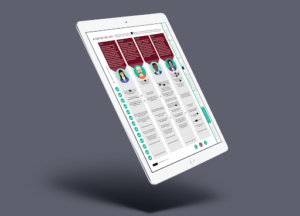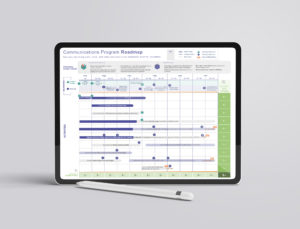Federal leaders today have more customers than ever and more channels through which to reach them – dramatically complicating the customer experience (CX) management strategies CX leaders have traditionally employed. Most recently, the President highlighted this challenge with the new Executive Order seeking to transform the government’s federal customer experience. The ever-increasing access to and speed of information makes an integrated and strategic communications plan critical for your agency; however, it’s not a one-size-fits-all approach.
Today we’re offering a few tips to help you identify your agency’s needs to help you get started.
“The first step in building your agency’s strategic communications plan is leadership alignment.”
Tip 1: Level Set & Align on Goals Early In The Process
Like the old saying goes, to know where you’re going you must know where you’ve been. That means asking some key questions, such as:
- Who are my agency’s customers and what are their needs? Remember to consider internal AND external customers.
- How does my agency communicate to those customers today?
- What do my customers gain from the information we communicate to them today?
- Is my agency’s communications function centralized, decentralized, or a combination? Would a shift help better serve our customers?
- Are my agency’s communications consistent and clearly branded regardless of who sends them?
- Is my agency communicating at the right cadence? If not, why?
Answering those questions may be difficult – and may uncover additional issues to solve in the development of your strategic communications function. Two examples of questions that might arise include:
- Q: Is my agency’s communications function centralized, decentralized, or a combination? Would a shift help better serve our customers?
A: Our strategic communications function is decentralized, but I believe centralization would be beneficial for our customers. However, there is a lack of trust that centralization will meet the needs of teams who have historically managed their own comms work. - Q: Is my agency communicating at the right cadence? If not, why?
A: No. There isn’t coordinated messaging which diminishes the overall understanding of our mission and makes it difficult for employees and customers to track what is important. We’re inadvertently oversaturating our customers.
What often becomes clear is the first step in building your agency’s strategic communications plan is leadership alignment on the audience and goals of communicating. That means engaging with your key customers as people, actively listening to their concerns, and co-solutioning the path forward. Taking the time to secure this buy-in upfront increases the likelihood the transformation you implement will stick.
Tip 2: Know Your Audience (and What They Need from You)

Customer personas
This isn’t as simple as it sounds. Remember your colleagues who have historically been running their own communications? Well, they’ve got their own audiences, too. Complicating things further, there’s likely overlap between audiences.
Where do you begin?
First, build out a customer persona – or more likely, personas. Use research to define audience segmentation. This runs the gamut from defining demographic traits to uncovering preferred audience information sources. For example, does your audience visit your website from their desktop or do they skew mobile? The goal is to uncover the characteristics that impact your agency’s interactions with them.
Next, develop a communications matrix covering what you need your audience to know and the best way to reach them. For example, your agency may issue reports for public consumption. And the data in those reports may be relevant to audiences across demographic spectrums. Combined with your customer personas, a communications matrix allows your agency to slot in the right content for the right audience in the right channel (i.e., social media; email; direct mail; etc.).

An example of a communications matrix for an organization.
Finally, track your learnings and use the data to optimize your communications strategy and KPIs. For example, does your output need to be more mobile friendly? Which of your reports gets the most visits on your website? Who opens your emails?
Feeding that data into your Customer Relations Management (CRM) allows you to take those learnings and create organizational value out of them. Ultimately, using data to improve your strategic communications plan improves your customer experience.
Tip 3: Incentivize with KPIs
Tip 2 covered the use of your CRM to optimize your strategic communications plans and function; however, your CRM is only as valuable as the data inputted. In large organizations, like federal agencies, the data that feeds your CRM isn’t coming from just one person – it’s coming from across teams, divisions, regions, etc.
This requires process education and active governance to make sure data is being correctly inputted. To encourage this, we recommend building CRM data input into your organization’s KPIs and personal performance plans, in addition to KPIs around performance, quality, and usability measures. This keeps communications priorities front and center and incentivizes the behaviors required to drive continued success.
This process may seem foreign to agency employees used to doing things a certain way. We recommend creating a visual stakeholder map including organizational information and how it flows. Add in who owns it and how it moves through the organization, including how it gets into your CRM. Taking the time to set this up creates a virtuous cycle of data-in, communications plans optimized, customer experience improved.
Next Steps
These are just the tip of the iceberg. Building a modern strategic communications function takes time, patience, and discipline. If you have questions around strategic communications or are wondering how to take your agency and customer experience to the next level, email me anytime at sonya.patel@theclearing.com.
If you liked this article, you might also like:


 The Clearing’s Employee Experience
Improvement model, adapted from Itam
& Ghosh, 2020, focuses on three objectives:
The Clearing’s Employee Experience
Improvement model, adapted from Itam
& Ghosh, 2020, focuses on three objectives: 


















